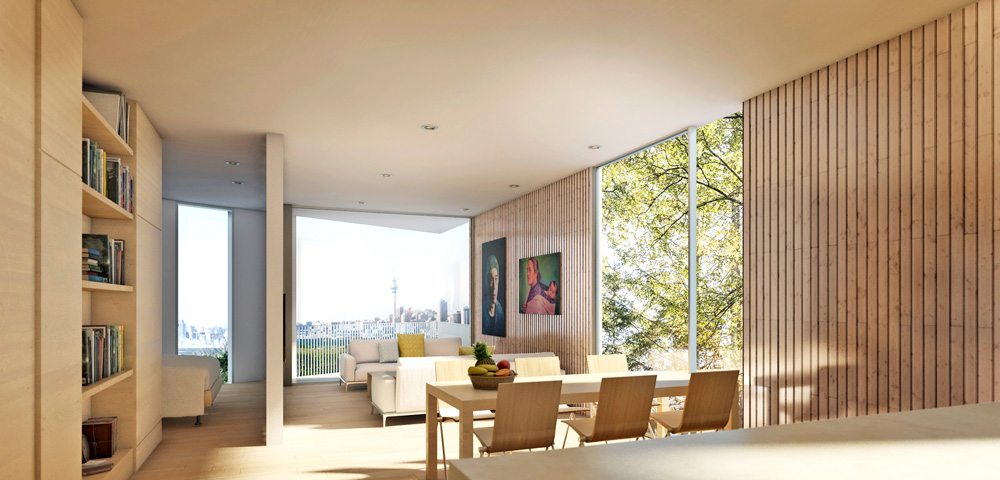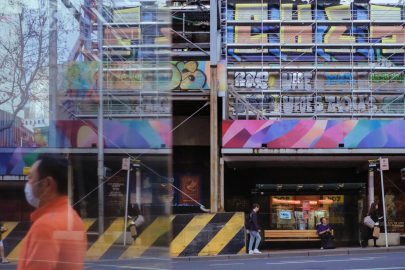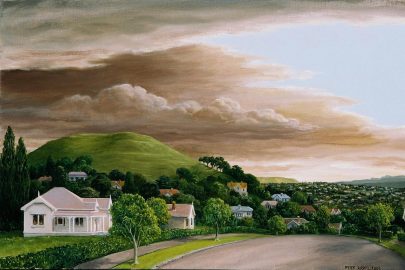Nov 3, 2014 Property
Mention “density” and all hell breaks loose.
First published in Metro, October 2014.
When the winner of the Akepiro St “exemplary apartment building” competition was announced, reaction was predictably knee-jerk. Herald property editor Anne Gibson went to that bastion of good taste, councillor Mike Lee, for comment. Lee, who once described the Queens Wharf sheds as “old and cheap and nasty” but flip-flopped when others fought for their heritage protection, gave his trademark view of the winning design.
“Cheap and shoddy,” he said, adding that such apartments were not big enough for families and that the building’s exterior was ugly. “I can just see this getting mouldy,” pronounced Lee. “If we’re going to have high-rise, they need to make it durable.” He correctly identified it as a six-floor timber apartment building, but didn’t seem to know it would be clad in copper, zinc or titanium.
Adding insult to injury, Gibson sought further balanced comment from Richard Burton of anti- intensification lobby group Auckland 2040.
The competition, which attracted 65 entries and was briefly on display at the Auckland Art Gallery in August, was organised by the NZ Institute of Architects and developer Ockham Residential, with the support of Auckland Council.
“Pigeons wouldn’t live in it. They have better taste.”
Predictably, Burton put the boot into the council’s involvement, saying it was an attempt to mitigate the public backlash against the Unitary Plan. Burton was “worried about widespread apartment development throughout suburban Auckland, particularly on sites which are inappropriate for intensification”. No mention that Akepiro St is a cul-de-sac beside the rail line near the Dominion Rd flyover, with no other residential buildings in the street. It’s eminently appropriate for intensification. Nor, for example, that solo parents with one or two kids, who constitute a significant number of families in New Zealand, might find living so close to the city centre, with public transport easily accessible, quite a good option. Nor that the building has unimpeded views across the city on three sides and a small reserve adjacent with 25m-tall Norfolk pines.
The derision kept coming. The Herald Facebook page featuring the five competition finalists was bombarded with around 200 mostly disparaging comments. “Bloody hideous,” said Donna. “Pigeons wouldn’t live in it. They have better taste,” opined Helen. “Looks like cardboard boxes,” said Tash. “All are ugly, hate them,” pronounced Bill. “Dull,” said Hugh. “Wtf aaarrrggghhh,” exclaimed Estelle. Running counter were a few who liked what they saw: “great”, “cool”, “brilliant”.
Then came the letters to the editor. “The Herald report on the finalists in the apartment design contest intended to re-assure Aucklanders wary of intensification plans,” wrote Cathryn of New Lynn. “The finalists unfortunately have done nothing to put my mind at rest, apart from being lower than the previously mentioned block of black cheese.” The black cheese was a reference to the new apartment building in New Lynn’s regenerated town centre, which Cathryn also disapproved of. “Have none of them considered irregular lines, beautiful colours?” asked Cathryn. “We have so many architects. How about they get more innovative?”

Dear, oh dear. This is what passes for architectural debate. As a city, it’s like we suffer from post-traumatic apartment disorder; after the fiasco of the Hobson St examples, whenever the word “density” is mentioned, all hell breaks loose. Who would want to be an architect?
Architects often let their drawings do the talking, which may have been part of the problem. The nature of apartments (floors stacked vertically), the small site, the planning rules and the tight brief requiring 25 units tended to dictate a six-floor box. But among the 65 entries, it was remarkable to see how hard the architects had worked to provide visual variation in the façades.
Cathryn called for irregular lines, beautiful colours and innovation. She might have noticed the array of coloured glass in the winning design by S3 Architects’ Stephen Smith, an architect passionate about sustainability, prefabrication and smarter building methods. The innovation may have been harder to see, but the apartment’s construction in cross-laminated timber wall and floor panels — roughly 150mm-thick sandwiches of crisscrossed tightly glued timber boards — is likely to make it the tallest timber building in the country. Unlike concrete, using timber embodies carbon in the construction, giving the building strong sustainability credentials. Coupled with other green features, including photovoltaic panels on the roof for electricity generation, a heat-recovery unit in the basement and highly insulated air-tight construction, the building is likely to get an unheard-of eight-star rating.
Probably the most innovative aspect is the parking — or rather the lack of it. The building is in a Special Housing Area, which means it gets fast-tracked to Unitary Plan regulations, which in mixed-use zones don’t have a minimum requirement for apartment parking. Ockham developer Mark Todd intends to provide just 10 parking spaces in the building’s basement. Three of those will be for shared cars, owned by the building’s body corporate, which can be booked by residents.
“I’m going to really cater to the young urban generation, people who are struggling to get on the property ladder.”
While the new parking rules make sites like Akepiro St much more economically viable, the competition highlighted how some Unitary Plan rules — such as the minimum studio apartment size of 40sqm and minimum balcony sizes of 8sqm — are overly restrictive. New York-style lofts and European examples show smaller can still be beautiful and balconies, especially when they open onto busy roads, aren’t always necessary.
Then there’s the cost. Special Housing Area affordability requirements demand that 10 per cent of the units have to sell for less than 75 per cent of the median house price in Auckland. With Auckland prices, that’s an ever-rising condition, but Todd expects the price to start at around $350,000 for one-bedroom units and go up to $600,000 or so for the largest 68sqm two-bedroom units. With lower-cost construction and fewer carparks, he expects the units to be selling at around $8000 per square metre, significantly less than the $10,000-$12,000 per square metre that apartments are currently selling for.
“I’m going to really cater to the young urban generation, people who are struggling to get on the property ladder, couples with one or no car who both work in the city,” says Todd. “We want to design this as one of the coolest, most progressive green buildings in the city.”
Architects clearly have more to do to win the debate about city apartment living, but as seen in the competition entries, their willingness to climb into the density ferment has spurred an admirable creative response. Now, instead of presuming their drawings will do the talking, they need to speak out about what they’re aiming to achieve.





